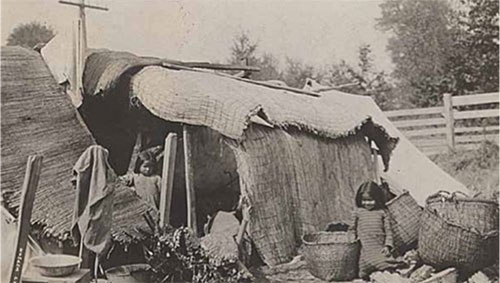GRADE 3
Curriculum Units and Materials |
|
|---|---|
GEOGRAPHYHow Do Natural Resources Influence Where and How People Chose to Live?Students will learn about the natural resources of Washington state and analyze why specific cultural groups chose to live in the Puget Sound region. Using maps and secondary sources, students will examine why it became more important to find better means of crossing Lake Washington to meet individual needs and wants. |

Indians in Canoe, ca 1911. Courtesy Museum of History & Industry |
| Download Entire Curriculum Unit and Materials zip file (zip 986kb) | |
| DOWNLOAD INDIVIDUAL FILES: | |
| CURRICULUM: How Do Natural Resources Influence Where and How People Choose to Live? (pdf 231kb) |
|
| ELEMENTARY ESSAYS: ELEMENTARY ESSAY #3: Living and Working on the Lake (pdf 209kb) | |
| ELEMENTARY ESSAY #4: Transportation on the Lake (pdf 123kb) | |
| MAPS: MAP #2: World Map (pdf 53kb) | |
| MAP #3: Lake Washington area marked with Native American villages (pdf 67kb) | |
| MAP #4: Transportation Corridors (pdf 137kb) | |
| WORKSHEETS: WORKSHEET #3: Using the Environment to Meet Needs and Wants (pdf 54kb) | |
| WORKSHEET #4: When Different Groups Came to Live and Work in the SR520 Project Region (pdf 58kb) | |
| WORKSHEET #5:Transportation Options for Crossing the Lake - Timeline (pdf 67kb) | |
| OSPI STANDARDS & ASSESSMENTS: CBA: Humans and the Environment EALRs: Reading, Social Studies, Science | |
CIVICSHow Do People Work Together to Solve Problems?Students will apply concepts of “individual rights” and “common good” to challenges that have faced different groups of people living or working in the Lake Washington area. They will also use these concepts to resolve conflicts and differences seen in everyday classroom interactions. | 
|
| Download Entire Curriculum Unit and Materials zip file(zip 252kb) | |
| DOWNLOAD INDIVIDUAL FILES | |
| CURRICULUM: How Do People Work Together to Solve Problems? (pdf 225kb) | |
| DOCUMENTS: Point Elliot Treaty Signature Page (pdf 192kb) | |
| WORKSHEETS: WORKSHEET #8: How Citizens Make a Difference in Matters Affecting Neighborhoods (pdf 54kb) | |
| OSPI Standards and Assesments CBA: Wholes rules? EALRs: Reading, Social Studies |
HISTORYWhat Can We Learn About Ourselves by Studying Other Cultures?Students will use maps, photographs, and elementary essays to learn about several specific cultural groups who lived in the Lake Washington area from 1850-1915. Students will examine whether past contributions made by each cultural group has affected their lives today. | 
Native American children near shelters. Courtesy Museum of History & Industry. |
| Download Entire Curriculum Unit and Materials zip file (zip 1.5 mb) | |
| DOWNLOAD INDIVIDUAL FILES | |
| CURRICULUM: What Can We Learn About Ourselves by Studying Other Cultures? (pdf 165kb) | |
| ELEMENTARY ESSAYS: ELEMENTARY ESSAY #3: Living and Working on the Lake - PRE 1850 through 1916 (pdf 204kb) | |
| PHOTOS: PHOTOS #3 (pdf 914 kb) | |
| MAPS: MAP #2: World Map (pdf 53kb) | |
| MAP #3: Lake Washington area marked with Native American villages (pdf 67kb) | |
| MAP #4: Transportation Corridors (pdf 137kb) | |
| WORKSHEETS: WORKSHEET #4: When Different Groups Came to Live and Work in the SR520 Project Region (pdf 58kb) | |
| OSPI Standards and Assesments CBA: Cultural Contributions EALRs: Reading, Social Studies |